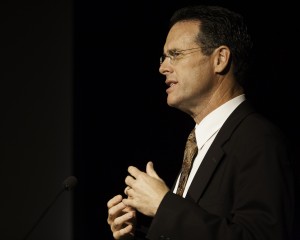A teaching calling in The Church of Jesus Christ of Latter-day Saints is practically inevitable for most members at some point in their service in the Church.

But for some members, it is easy to forget that the most important place to teach and serve is the home. Brother Matthew O. Richardson, Second Counselor of the Sunday School General Presidency, taught in his Education Week address Wednesday that teaching and learning is the centerpiece of the home.
He said he was in a meeting with President Thomas S. Monson discussing Sunday School matters and how to bolster the educational programs. President Monson wagged his finger at him and said, “Improve learning and teaching in the Church and home.”
Most of the time, Richardson said, we forget how to teach and learn in the home. It’s easy to go home on Sundays and then fade back into a worldly lifestyle, which is backwards.
Richardson illustrated this with a study and a simple pie chart. The study surveyed members of the Church from North America on how often they participate in other church-related activities besides Sabbath observance. These activities include scripture study, family home evening and others. In most activities, one-third of those surveyed did these things, one-third “dabbled” and one-third didn’t.
“This was a bit alarming,” he said, considering those surveyed were actively attending Sunday activities. Richardson related this to an old Chinese proverb from the Confucian scholar Wang Ling Ming.
“There has never been a people who know but do not act. Those who are supposed to know but do not act simply do not know,” he said.
Richardson proposed that those who are not active in these other activities may simply not know enough to act to do these things. And that’s because the learning and teaching that is necessary in the home isn’t there.
“We need to teach them,” he said. “My thought is, how do you do that?”
An idea proposed by the audience was to be an example.
“Modeling becomes an important part of teaching, especially in the home,” Richardson said.
When former David O. McKay was a missionary in Scotland in the 1890s, he experienced a lot of hardships and took a little break for a while. Richardson said McKay and his companion were walking past a house and noticed an interesting stone in the architecture.
Upon closer examination, it read, “Whate’er thou art, act well thy part.” This completely changed his mission experience and he was able to be an example in teaching and learning.
When each member of the family is learning and teaching actively together, they are fulfilling their individual parts. They can then “harvest their experiences” and teach unto others.
Richardson then discussed the difference between teaching unto someone and teaching into them. Richardson related a quote from President Henry B. Eyring, “Our aim must be for individuals to be truly converted to the gospel of Jesus Christ. The pure gospel of Jesus Christ must go down into the hearts of people by the power of the Holy Ghost.” Without the power of the Holy Ghost, a message of the gospel cannot go into someone’s heart.
Richardson concluded with two rhetorical questions: “How am I being in my home? Do I provide opportunities to act?” As examples are made in the home and provide others with the opportunity to be “what e’er thou art,” the home becomes a learning and teaching environment.
“Brothers and sisters, act we must.”




